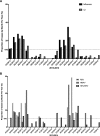Burden and Seasonality of Viral Acute Respiratory Tract Infections among Outpatients in Southern Sri Lanka
- PMID: 28719323
- PMCID: PMC5508919
- DOI: 10.4269/ajtmh.17-0032
Burden and Seasonality of Viral Acute Respiratory Tract Infections among Outpatients in Southern Sri Lanka
Abstract
In tropical and subtropical settings, the epidemiology of viral acute respiratory tract infections varies widely between countries. We determined the etiology, seasonality, and clinical presentation of viral acute respiratory tract infections among outpatients in southern Sri Lanka. From March 2013 to January 2015, we enrolled outpatients presenting with influenza-like illness (ILI). Nasal/nasopharyngeal samples were tested in duplicate using antigen-based rapid influenza testing and multiplex polymerase chain reaction (PCR) for respiratory viruses. Monthly proportion positive was calculated for each virus. Bivariable and multivariable logistic regression were used to identify associations between sociodemographic/clinical information and viral detection. Of 571 subjects, most (470, 82.3%) were ≥ 5 years of age and 53.1% were male. A respiratory virus was detected by PCR in 63.6% (N = 363). Common viral etiologies included influenza (223, 39%), human enterovirus/rhinovirus (HEV/HRV, 14.5%), respiratory syncytial virus (RSV, 4.2%), and human metapneumovirus (hMPV, 3.9%). Both ILI and influenza showed clear seasonal variation, with peaks from March to June each year. RSV and hMPV activity peaked from May to July, whereas HEV/HRV was seen year-round. Patients with respiratory viruses detected were more likely to report pain with breathing (odds ratio [OR] = 2.60, P = 0.003), anorexia (OR = 2.29, P < 0.001), and fatigue (OR = 2.00, P = 0.002) compared with patients with no respiratory viruses detected. ILI showed clear seasonal variation in southern Sri Lanka, with most activity during March to June; peak activity was largely due to influenza. Targeted infection prevention activities such as influenza vaccination in January-February may have a large public health impact in this region.
Conflict of interest statement
Disclosure: Christopher W. Woods has served in an advisory capacity to Becton, Dickinson, and Company.
Figures

Similar articles
-
Respiratory Viral Infection: An Underappreciated Cause of Acute Febrile Illness Admissions in Southern Sri Lanka.Am J Trop Med Hyg. 2019 Mar;100(3):672-680. doi: 10.4269/ajtmh.18-0699. Am J Trop Med Hyg. 2019. PMID: 30594268 Free PMC article.
-
[Prevalence and seasonal distribution of respiratory viruses in patients with acute respiratory tract infections, 2002-2014].Mikrobiyol Bul. 2015 Apr;49(2):188-200. doi: 10.5578/mb.9024. Mikrobiyol Bul. 2015. PMID: 26167819 Turkish.
-
Influenza and other respiratory virus infections in outpatients with medically attended acute respiratory infection during the 2011-12 influenza season.Influenza Other Respir Viruses. 2014 Jul;8(4):397-405. doi: 10.1111/irv.12247. Epub 2014 May 23. Influenza Other Respir Viruses. 2014. PMID: 24852890 Free PMC article.
-
Etiology of acute viral respiratory infections common in Pakistan: A review.Rev Med Virol. 2019 Mar;29(2):e2024. doi: 10.1002/rmv.2024. Epub 2018 Dec 12. Rev Med Virol. 2019. PMID: 30548740 Free PMC article.
-
Electronic Health Record-Based Algorithm for Monitoring Respiratory Virus-Like Illness.Emerg Infect Dis. 2024 Jun;30(6):1096-1103. doi: 10.3201/eid3006.230473. Emerg Infect Dis. 2024. PMID: 38781684 Free PMC article. Review.
Cited by
-
Viral burden and diversity in acute respiratory tract infections in hospitalized children in wet and dry zones of Sri Lanka.PLoS One. 2021 Dec 17;16(12):e0259443. doi: 10.1371/journal.pone.0259443. eCollection 2021. PLoS One. 2021. PMID: 34919553 Free PMC article.
-
Molecular Epidemiology and Clinical Characteristics of an Outbreak on Respiratory Virus Coinfection in Gansu, China.Viruses. 2024 Mar 30;16(4):540. doi: 10.3390/v16040540. Viruses. 2024. PMID: 38675883 Free PMC article.
-
Clinical and epidemiological characteristics of influenza virus infection in hospitalized children with acute respiratory infections in Sri Lanka.PLoS One. 2022 Sep 2;17(9):e0272415. doi: 10.1371/journal.pone.0272415. eCollection 2022. PLoS One. 2022. PMID: 36054097 Free PMC article.
-
Use of clinical algorithms and rapid influenza testing to manage influenza-like illness: a cost-effectiveness analysis in Sri Lanka.BMJ Glob Health. 2019 Mar 30;4(2):e001291. doi: 10.1136/bmjgh-2018-001291. eCollection 2019. BMJ Glob Health. 2019. PMID: 30997171 Free PMC article.
-
Pre-COVID-19 epidemiology of community respiratory viruses at a single US center reveals sex differences in influenza A and a higher ICU incidence of human metapneumovirus in the elderly population.BMC Infect Dis. 2025 Jul 18;25(1):924. doi: 10.1186/s12879-025-11307-5. BMC Infect Dis. 2025. PMID: 40681977 Free PMC article.
References
-
- Ferkol T, Schraufnagel D, 2014. The global burden of respiratory disease. Ann Am Thorac Soc 11: 404–406. - PubMed
-
- Molinari NA, Ortega-Sanchez IR, Messonnier ML, Thompson WW, Wortley PM, Weintraub E, Bridges CB, 2007. The annual impact of seasonal influenza in the US: measuring disease burden and costs. Vaccine 25: 5086–5096. - PubMed
-
- Peasah SK, Azziz-Baumgartner E, Breese J, Meltzer MI, Widdowson M-A, 2013. Influenza cost and cost-effectiveness studies globally: a review. Vaccine 31: 5339–5348. - PubMed
-
- Puzelli S, Valdarchi C, Ciotti M, Dorrucci M, Farchi F, Babakir-Mina M, Perno CF, Donatelli I, Rezza G, 2009. Viral causes of influenza-like illness: insight from a study during the winters 2004–2007. J Med Virol 81: 2066–2071. - PubMed
Publication types
MeSH terms
LinkOut - more resources
Full Text Sources
Other Literature Sources
Medical

